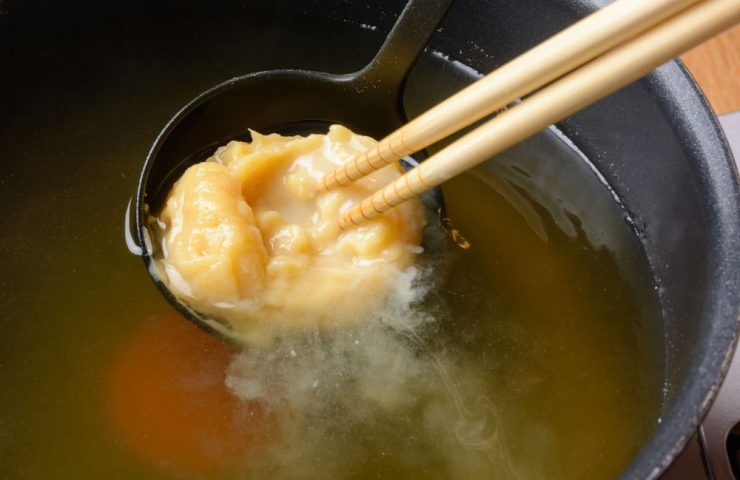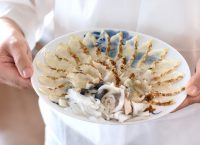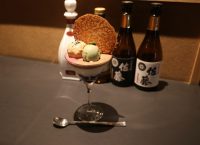Japanese traditional seasoning, Miso Have you heard of Kanemitsu Miso from Fuchu City, Hiroshima which 90% of their income is from overseas?!

Fuchu, Hiromshima / Onomichi POSTED on 2019.11.06
Fuchu, Hiromshima / Onomichi POSTED on 2019.11.06
If you are Japanese or have lived in Japan for a while, you would know that Miso is one of the representation of Japanese food culture and a tradition.
But did you know that there is a miso warehouse where 90% of their income comes from outside of Japan?
Kanemitsu Miso is the miso warehouse mentioned above. It is based in Fuchu City, Hiroshima. Fuchu City of Hiroshima Prefecture is known for Fuchu Miso, with 400-years history, and Kanemitsu Miso has taken over traditional method of Fuchu Miso.
But why is Kanemitsu Miso so popular overseas?!
We visited the warehouse and asked Koichi Kanemitsu, the third generation representitve of Kanemitsu Miso.

Fuchu Miso, the Pioneer of low-salt miso
Fuchu City, Hiroshima is a basin surrounded by the Chugoku Mountains that supply high-quality water. Fuchu Miso was originally made in each household for just private consumption but eventually was put on a corporate sales route by a local merchant. It only became famous when they exhibited their white miso at an exposition in Nara, where it won the highest award.
The characteristics of Fuchu Miso are the long natural brewing time and the proportion of Koji (Japanese yeast). The amount of Koji is higher than ordinary miso, so it has less salt. Therefore, Fuchu Miso became famous for low-salt healthy miso and had more than 10 miso warehouses in the area back in the times but due to time and trends, there are now only 3 miso warehouses left in town.
Organic
The reason why Kanemitsu Miso is so popular overseas

Kanemitsu Miso was founded in 1872 and has history of 147 years. They used to make Shoyu, Miso and Sake but because making of miso highly depend on how it is fermented and the first generation owner thought it could have the most originality out of all three, and decided to just make miso. They have been specializing in miso making ever since.
Kanemitsu Miso have been maintaining the traditional manufacturing method of Fuchu Miso but also is commited about being organic.
This leads directly to oversea popularity.
“My father, who represented as second generation had a thing about health. I, on the other hand liked strong and salty taste with things like amino acid seasonings. So I didn’t like the food at home and we also used to have a lot of fights over our miso indigredients. But then, at some point, it really scared me how a seasoning can change the taste of food we eat completely.”

The commitment to using organic indigredients reached overseas and they decided toaquire international organic certification, OCIA International in 1982 and have been certified ever since. At that point, Japan has entered the mass production era, so they decided to withdraw from the Japanese supermarkets and steer its business target to overseas whole food market that handles natural and organic foods.
“We have been tackling two main shaft in our business, tradition and organic. Japanese markets like to go with one thing they decide but overseas are more open to change. That is why our miso was accepted overseas, something new.”
Many miso warehouses and miso suppliers have closed down recently but Mr. Koichi Kanemitsu, the third generation representive have shifted to more proactive business instead to save their miso.
They changed the package design to go with the oversea needs and made a new slogan;“Innovation is to keep the tradition and change with time”. Japanese tradition was often kept by “look, and learn” culture but they decided to visualize all the data and numbers and mechanized the parts where it could be to secure the production capacity. They are also hiring actively for young employees from all over.

Keeping the tradition part; Living with 100 year established Kanemitsu Miso koji molds
To hear more specific stuff, we were taken to the heart of miso making, the warehouse. In order to meet the OCIA certficate needs, we wore masks and sanitized ourseves before we went in.

We were taken to the third floor of the warehouse first, where there was a huge iron kettle for steaming the coybeans.
Since soybeans contain a lot of oil, stainless steel pots are mainly used for this process. However, at Kanemitsu Miso, they use high thermal conductable iron kettle which is hard to maintain but also makes it possible to steam soybeans more deliciously.

When I looked up, I saw a lot of mold on the pillars and ceiling. These bacteria are the rivals of Kanemitsu Miso koji molds” which is the heart of fermentation. The fungi are essential for producing the taste of Kanemitsu Miso because miso does not become strong without a rival.

Then, we went one floor down to Koji floor.
When the koji molds are planted in rice that has been steamed in a rice koji pot and then cooled, the hyphae grow. The larger the hypha, the better the miso, soy sauce, and sake. This process used to be done by sense of the miso producer but Mr. Koichi has succeeded in data conversion and has improved reproducibility.

On the first floor, cedar barrels are stored.
The cedar barrel is the biggest feature of Kanemitsu Miso, and they are probably the only ones amongst the mass miso producers who uses the cedar barrel in all of West Japan. This is because the Japanese Food Hygiene Bureau once forbid the use of cedar barrels and many miso producers were forced to throw them away. Kanemitsu Miso did not throw away their barrel because they already had a significant amount of income overseas.
This cedar barrel is laid with miso during aging, and as it matures, it swells more and more and overflows from the top of the barrel. Fungi live in the cedar barrels. So don’t wash it clean. Miso has a very low cause of food poisoning called water activity, so even if priority is given to leaving bacteria, there is no health problem.


By seeing the warehouse, you can see once again that Kanemitsu Miso is not born overnight but is born over many years. As we went on the tour, we felt that Kanemitsu Miso Koji molds are certainly alive.
Komedoko Dining in Onomichi, Hiroshima, delivers Japanese good old food culture
To taste the long established Kanemitsu Miso, you can visit “KOMEDOKO Dining”in Onomichi, not far from Fuchu.

“Komedoko Dining”features on rice and fermentation and provide their service based on the concept of “Food for your heart and health”. They used to use commecially made miso but since they met Kanemitsu Miso, they thought it is a perfect match with the store concept and were also so impressed by the quality of it and now uses for majority of their menus.
“The aged product has a great umami component. I thought it could n’t be made at the store. The taste deep, so it ’s fine with less seasoning.”says Ms. Miyazawa who decided to use Kanemitsu Miso at the store. She made miso croquette using Kanemitsu Miso at the store once and saw all the potatoes melt and felt like koji in the miso is still alive and decided to use it.

“Recently, you don’t make miso soup at home, you don’t have vinegared food, boiled food, and soup stock. It ’s also a suggestion from us that there are still some amazing Japanese food culture in Japan to young people who don’t know that. ”
Of course, they use Kanemitsu Miso for miso soup, but this time we tried the “Miso platter” and “Grilled scabbard fish with Koji and Lemon”. The miso platter changes the ingredients depending on the season, and you can taste the taste of Kanemitsu Miso directly.

“If you were to describe the deliciousness of Kanemitsu Miso in one word, it would be “Umami”. It is said that there is depth due to aging rather than a monotonous taste. Although it’s less salty than general miso, it’s not without salt, but when it matures, the taste gets better”says Ms. Miyazawa.
“Some tourists from overseas say that there is no other food like this around the area. If the people from overseas feel that way, I hope Japanese people will re-realize the great Japanese food culture through our food, too.”

Komedoko Dining
Address: 2nd floor, 5-2, East Gosho-machi, Onomichi, Hiroshima 722-0036
Business hours: Lunch: Tue-Sun 11:00 to 14:00, Dinner: Tue-Sat 17:00 to 22:00(L.O. 21:00), Sun 17:00 to 21:30(L.O. 21:00)
Holidays: Monday
Website: https://komedokoshokudo.gorp.jp/
Fermentation is part of Japanese food culture
“Kanemitsu Miso mold only grows in this warehouse. Miso we make here is the taste of Kanemitsu.” says Koichi Kanemitsu.
There is a say in where the taste of yeast you experience for the first time in your life becomes the taste of yeast for your life. Overseas, it was Kanemitsu Miso, so customers come back to this taste every 100 years. That’s why the business partner will not change.
We often say that miso soup made by your mother is the “taste of mom”. This is probably why we keep going back or have a particular memory to it.
This is the greatness of fermented food.

Kanemitsu Miso keeps the traditional method of Fuchu Miso making but also delivers the good Japanese food culture to overseas. In Japan, it is used for school meals as well as restaurants. They started offering their miso to schools because they want the Japanese children to remember how great the Japanese culture is.
It may be a good idea to start with miso for your healthy life.
Kanemitsu Miso
Address: 628 Naka-machi Fuchu, Hiromshima
Business hours: Mon-Sun 8:00 to 17:00
Holidays: Sunday
Website: http://www.kanemitsu-miso.co.jp/
- Writer
- Hiroaki Hata
- Photographer
- Hiroaki Hata
ソトレシピLOCAL GUIDE
-
 For more
For moreManager at coffee and baked cake cafe "nagi" / Publisher of ".HYAKKEI"
Hiroaki Hata(Hiroaki Hata)
information
Related articles
-

[NEWS] Collaboration of Japanese Kawaii Culture and Japanese Cuisine
Harajuku and Omotesando area in Tokyo are the sacred
- from:
- Minami Aoyama, Minato-ku, Tokyo
- genre:
- Experience / Eat
POSTED on 2019.11.06
-

Only one in the world! The fugu* cooking professional initiates Challenge the tora fugu* cooking experience at Shimonoseki
* puffer fish *2 tiger puffer fish Shimonoseki pri
- from:
- Karato-cho, Shimonoseki-shi, Yamaguchi
- genre:
- Experience / Learn / Eat
POSTED on 2019.09.18




